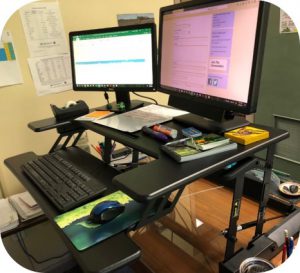
by Dorothy C. Lee | Dec 3, 2018

Holiday Stress
Photo source: Dorothy Lee
Tis the Season Merry and Bright:
From Thanksgiving to New Year’s Eve there are greater incidences of stress and tension related headaches and migraines. Family stresses, long shopping lines, and unrealistic expectations are enough to trigger tension headaches even in people who are not headache prone. To avoid these aches and pains a strategic plan may be necessary.
Planning is crucial not only at the holidays but throughout the year. Having a plan and being organized makes everything easier and more manageable. The key is to start early and don’t wait until December. This is where Christmas in July becomes useful thinking.
The following are some tips to help avoid stress during the holiday season. Make a schedule that includes all tasks you have to complete, how long you think each task will take, and when each task needs to be completed. This is why Santa makes a list and checks it twice.
- Start shopping early to reduce time wasted in long lines with early-bird hour sales
- To avoid long period of times wrapping, shop in stores where gift wrap is free
- Shop on-line while drinking your coffee in your pajamas
- Track your purchases in a notebook or in note section of your cell phone
- Prioritize your social events and don’t spread yourself too thin
- Use your computer for online postal mailing to avoid lines at the post office
- Instead of mailing gifts, order gifts on-line, and have gifts directly sent to gift recipient
- Practice relaxation and stretching to reduce stress
- Establish a spending limit and stick to it
Be realistic about how much you can do as nobody likes a cranky Santa. By following these tips, you will be as jolly as old Saint Nick.
Enjoy the holiday season with family and friends as it is the greatest gift you can give yourself. And remember, laugher is the best medicine for stress!
Happy Holidays!

by Judy Corbus | Nov 15, 2018

Photo source: UF/IFAS Northwest District
After an extended power outage, your refrigerator and freezer may develop unpleasant odors from spoiled food. To get rid of these odors, remove all food items and clean the inside, including drawers and bins, with a mild cleaning solution of dish soap and water. You also can use a solution of 2 tablespoons baking soda and 4 cups warm water. Strong cleansers may affect the taste of food or ice cubes or damage the interior finish. Rinse with a bleach solution of one tablespoon unscented chlorine bleach per gallon of water to sanitize. Lemon juice and water solutions are not strong enough to sanitize effectively. Leave the unit unplugged with the door open for 1-2 days to air out. Spray disinfectant around hinges, locks, and into any openings.
If odors persist, try one of these methods:
- Spread activated charcoal, clean cat litter, or baking soda on trays and place on refrigerator or freezer shelves. Activated charcoal is extra dry and absorbs odors more quickly than cooking-type charcoal. It is available at drug or pet supply stores. Run the appliance empty for 2-3 days. If the odor remains, replace with new charcoal and repeat.
- Place trays of freshly ground coffee on appliance shelves and close the door. Run the appliance empty for 2-3 days. If a slight coffee aroma remains, wash and rinse shelves and the aroma should dissipate.
- Pack each shelf with crumpled newspaper. Set a cup of water on the top shelf or sprinkle the newspaper with water. Allow appliance to run for approximately 5-6 days. While this method is time-consuming, it is effective in removing strong odors.
- Use a commercial product designed for refrigerator and freezer odor removal. These products are available at hardware, grocery, discount, and variety stores.
Once the odor is gone, rinse and dry the appliance. Don’t forget to clean gaskets with a mild cleaning solution and warm water; rinse and dry. Dirt and spills can prevent the gasket from sealing well, resulting in a loss of cold air and higher utility bills. Also, clean the coils and front grill with a brush or vacuum cleaner to remove dirt that can hinder air flow to the condenser.
Use an appliance thermometer to check the temperature of your refrigerator and freezer. The refrigerator should be between 33˚F and 40˚F and the freezer at 0 degrees or below.
If there is still an odor after trying these steps, it is possible meat or fish drippings have seeped into the insulation. An appliance service technician may need to remove the liner and replace the insulation or the appliance may need to be replaced.
Sources:
My Florida Home Book – University of Florida/IFAS Extension
Solving Odor Problems in Your Refrigerator or Freezer – University of Nebraska-Lincoln Cooperative Extension
When the Power Goes Off – Clemson Cooperative Extension
Cleaning the Fridge – North Carolina State University Cooperative Extension

by Angela Hinkle | Oct 28, 2018
You want to help but don’t know how? Maybe you don’t have much money and you don’t have skills, time, or transportation to get to hurricane Michael victims for clean up or rebuild. One easy, low-cost way to help is peanut butter.
Yes, peanut butter helps hurricane victims
Peanut butter tastes good. It is safe at room temperature – no need to refrigerate or heat. Great when there is no electricity. And it’s super easy. Spread on bread or nosh on a spoonful.

Nutty for Peanut Butter
Photo Source: Angela Hinkle
“I am so hungry. What are we going to eat?”
These words were repeated throughout affected areas of the Florida panhandle after the Michael disaster ripped through towns. Peanut butter was the answer for many. A great filler upper loaded with important protein.
The Peanut Butter Challenge
During the months of October and November, UF/IFAS Extension offices in the Florida panhandle are collecting peanut butter for the Peanut Butter Challenge. Peanut butter is dropped off at collection sites by gracious donors – like you. Then at the beginning of December, the peanut butter is distributed to hungry families in need at local food pantries. Because so many of our family, neighbors, and friends were affected by hurricane Michael, much of this peanut butter will also be headed to them this year.
Peanut Proud
Peanut Proud and others have already donated 36,000 jars of peanut butter to affected areas. While many jars will be “spread” throughout all Florida panhandle county pantries, much peanut butter will be distributed to hurricane Michael affected areas.
Gift Cards
Looking for other ways to help. Gift cards to Home Depot, Lowes, Ace, Walmart, etc. are greatly appreciated. These cards allow people to get what they need. No guesswork involved.
To find out how and where to donate as well additional recovery information, contact your local Northwest District UF/IFAS Extension office. University of Florida IFAS directory
by Samantha Kennedy | Oct 16, 2018

Downed trees and other debris should be handled carefully. Use proper equipment and follow all safety precautions to avoid injury. (Photo source: Samantha Kennedy)
Hurricane Michael was a storm of historic proportions, slamming into the Florida Panhandle and wreaking havoc on millions of people across the Big Bend region. Now that the storm has passed, the recovery phase has begun. Damage assessment, debris removal, structural repairs, and food safety concerns are just a few aspects of storm recovery, as people seek to rebuild their lives and return to a sense of normalcy.
There are a lot of things to think about after a disaster and it can be overwhelming. The first priority should always be basic necessities: food, water, and shelter. Make sure any structure is safe enough for habitation. If the structure’s integrity is compromised, seek alternate living arrangements.
Heed all boil water notices, if applicable. If boiling water is not possible, stick to using clean, bottled water for drinking, food preparation, and personal hygiene. Do not assume that because the food in the refrigerator is cool to the touch, that it is safe to eat. Perishable food must be kept at or below 40 degrees Fahrenheit to be considered safe. If it is uncertain as to whether that temperature was maintained while the power was out, the food should be discarded. Discard any perishable food from refrigerators after a power outage longer than 4 hours.
Be careful when assessing damage after the storm. Wear sturdy shoes and avoid wading through floodwaters. Wear a hat, sunglasses, and sunscreen when out in the sun. Drink plenty of clean water and maintain energy levels with small, nutrient-dense meals and snacks. Damaged tree limbs may continue to fall after the storm, so take heed of potential falling debris. Standing water can harbor snakes, fire ants, and other potentially dangerous critters, so take proper precautions at or around puddles or floodwater.
Use tools such as chainsaws and generators correctly and practice proper safety precautions. Do not run a generator inside and store gas cans a safe distance from both the generator and the living space. Allow others more skilled with using a chainsaw to help with debris collection and removal. If dealing with large amounts of mold, be sure to wear protective clothing and the proper respiratory mask to avoid contact with spores.
Unfortunately, many dishonest people take advantage of situations such as natural disasters to prey on those in need. Beware of people offering to help with repairs quickly and/or for an extraordinarily low price. Only hire reputable licensed contractors, even if that means having to wait for services. The Florida Department of Business and Professional Regulation myfloridalicense.com maintains a list of licensed contractors in the state of Florida. The Better Business Bureau provides ratings for a variety of businesses, including contractors. Use these resources as a guide to finding the right contractor.
Contact insurance companies as soon as possible after the storm to get the claims process rolling. Have the policy on hand when the call is made to make the process easier. It would be helpful to document any damage and have those photos available to share with the insurance agent or claims adjuster. Post-disaster is an extremely busy time for insurance companies, so be as cooperative and patient as possible during the process.
Disaster recovery is a very stressful time for everyone, often leading to confusion, anger, and helplessness. Reach out to existing support systems such as family, friends, churches, or other groups for emotional support. Practice self-care, such as regular meals and breaks. Establish a new normal routine and stick to it, especially for children. Most importantly, be kind to yourself and others during this difficult time.
The University of Florida IFAS Extension Service is a local resource for post-disaster education and assistance. More information about each of these topics and more can be provided by your local extension office.
The UF/IFAS Disaster Preparation & Recovery blog is a comprehensive resource to help with disaster recovery: http://disaster.ifas.ufl.edu/.
Extension classes are open to everyone regardless of race, creed, color, religion, age, disability, sex, sexual orientation, marital status, national origin, political opinions or affiliations.

by Angela Hinkle | Aug 23, 2018

Healthy Pantry
Photo Source: Angela Hinkle
We eat to survive, right? Yes, but when you really think about it, we eat to thrive. Food is more than calories for energy. Food brings family and friends together. It provides comfort. It makes our bodies healthy and can protect us from diseases. The next time you give to a food pantry, think about what you can give to help those in need thrive, not just survive. So, how do you donate food to thrive?
A Balanced Diet
It’s important to eat from every food group every day. It’s important to give those in need the chance to eat every food group every day. This way, they get a variety of nutrients needed for healthy bodies. Choose healthier choices from each food group. See https://www.choosemyplate.gov/ for more information.
Fruits & Veggies: Half MyPlate
- Fruits and vegetables provide so many good vitamins, minerals, fiber, and water.
- All forms count – canned, frozen, fresh, dried, and juice.
- Canned fruit in 100% juice (Lite or heavy syrup equals a little or a lot of added sugar.)
- Juices that are 100% fruit or vegetables.
- Low- or no-sodium canned vegetables (Higher sodium intake tends to go hand-in-hand with higher blood pressure.)
- Try to stay away from high-fat, high-sodium, and high-sugar syrups and sauces.
- Packaged dried fruits and veggies are both popular now.
- The more fruits and vegetables, the better!
Whole Grains
- The whole edible part of the grain plant gives us fiber and loads of nutrients to keep us healthy. They even have special parts that help fight diseases.
- Look for the word whole at the beginning of the ingredient list.
- Help pantries stock whole grain crackers, hot and cold cereals, and tortillas. Donate whole grain pasta and brown rice.
Lean Proteins
- Protein helps build and repair tissue.
- Protein provides the building blocks of muscles, bones, skin, and blood.
- Go for lower-sodium and lower-fat choices. (Most of us over the age of two don’t need that extra fat.)
- Donate tuna, chicken, or salmon in water.
- Peanut butter is always popular.
- Try offering a variety of packaged seeds and nuts.
Dairy
- The calcium in dairy foods makes strong bones and teeth.
- Try low-fat versions of shelf-stable milk.
- Non-fat dry milk is great for sauces and casseroles as well as drinking. (If used for drinking, it tastes best to add the coldest water possible.)
- Low-fat yogurt and cheeses are a nice complement for pantries with refrigeration.
- For those who can’t have dairy, offer calcium-fortified soy or almond milk, cereal, or orange juice.
So don’t just think “feed them” when you donate, think “feed them well.” Donate beyond survive. Donate to thrive.

by Amy Mullins, PhD, RDN | Jul 26, 2018

Get out of your chair. Photo source: Amy Mullins
Have you ever thought about how many hours a day you spend sitting? Sitting at your desk, sitting in front of a computer, sitting watching television, sitting in the car, sitting, sitting, sitting. On average, Americans sit approximately 13 hours a day and sleep 8 hours adding up to a whopping 21 hours of inactivity. All of this sitting around may in fact be shortening our lives.
The cumulative effect of daily inactivity, or sedentary time, has contributed to a nationwide crisis of escalating chronic health conditions that include obesity, heart disease, high blood pressure, stroke, certain cancers, and type-2 diabetes. According to research, including a 2014 Harvard study of over 92,000 women, the risk of dying from stroke, heart disease, and cancer increases with the more time spent standing. In addition, the negative effects of excessive sitting seem to be just as strong in people that participated in a regular exercise regimen!
Standing Has Many Benefits
Our bodies increase a fat-burning enzyme called Lipoprotein Lipase when muscles are activated. This doesn’t just happen during purposeful exercise, but even during periods of standing. In fact, standing burns 30% more calories than sitting still! Regular engagement of muscles keeps them in a more continuous metabolic state that helps improve blood cholesterol, blood pressure, and blood sugar levels. Regular intervals of standing with minimal movement does all of this and so much more:
- Improves posture
- Tones muscles
- Increases blood flow
- Improves metabolism
- Improves mood
- Increases mental energy
- Reduces fatigue
During a typical day at work, experts recommend not sitting for more than 20 minutes at a time with regular intervals of standing. Standing up and walking even for just 5 minutes can lift your mood, increase mental energy and productivity, and can even dull your urge for unnecessary snacking.
What You Can Do

Standing desk. Photo source: Amy Mullins
Get up and move more! Consider some of these ideas to help in your quest to be more active during the day:
- Create a culture of health and encourage others in your workplace to support one another.
- Purchase a “standing desk” or get creative and make one to meet your needs
- Use a smartphone app, wrist monitoring device (such as a FitBit), or just an alarm on your phone or desktop to remind you to stand up and stretch or to walk outside for some fresh air.
- Instead of emailing or calling a co-worker, get up and take a stroll down the hall.
- On a conference call? Stand, move, stretch, do squats or desk push-ups.
- Take the stairs as often as you can.
- Forget hum-drum meetings in the conference room! Get creative on your feet and schedule walking meetings.
- Skip the afternoon coffee and energize with some office exercises. Consider getting an exercise mat, resistance band, stability ball and light weights.
- Wear comfortable shoes and clothing to the office and enjoy part of your lunch break taking a brisk walk and/or stretching.
- Bring your own reusable bottle to work and drink more water throughout the day. More water means more times you’ll have to walk to the restroom!
It’s not easy to create positive habits, but your health is worth it. But, making even a few changes to your normal routine can put you on a path to a happier and healthier life. For additional information about healthy habits in the workplace, visit:
NIH U.S. National Library of Medicine
U.S. Division of Occupational Health and Safety
CDC Workplace Health Promotion
University of Michigan Computer Ergonomics











